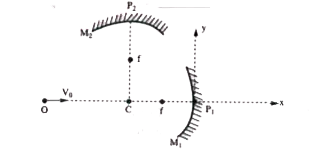Two identical concave mirrors M1 & M2 with principal axes perpendicular to each other and pole P1 of mirror M1 at origin is as shown. Let 'f' be the focal length and C be the common centre of curvature for both mirrors. A point object 'O' is at (-5f, 0) and is moving with a velocity →V=V0ˆim/s

Consider rays incident on mirror M1, the coordinates of the final image is
at position (-x, 0) and moving along x -axis
at position (+x,0) and moving along x- axis
at position (-x, 0) and moving along y - axis
at position (+y,0) and moving along y - axis
The correct Answer is:A
Related Playlists
- BOOK - AAKASH SERIESCHAPTER - GEOMETRICAL OPTICSEXERCISE - PRACTICE SHEET (EXERICSE-II (LEVEL-II (ADVANCED) MATRIX MATCHING TYPE QUESTIONS))1videos
GEOMETRICAL OPTICS
- BOOK - AAKASH SERIESCHAPTER - GEOMETRICAL OPTICSEXERCISE - PRACTICE SHEET (EXERICSE-II (LEVEL-II (ADVANCED) INTEGER TYPE QUESTIONS))5videos
GEOMETRICAL OPTICS
- BOOK - AAKASH SERIESCHAPTER - GEOMETRICAL OPTICSEXERCISE - PRACTICE SHEET (EXERICSE-II (LEVEL-II (ADVANCED) STRAIGHT OBJECTIVE TYPE QUESTIONS))2videos
GEOMETRICAL OPTICS
- BOOK - AAKASH SERIESCHAPTER - ELEMENTS OF VECTORSEXERCISE - QUESTIONS FOR DESCRIPTIVE ANSWERS9videos
ELEMENTS OF VECTORS
- BOOK - AAKASH SERIESCHAPTER - LAWS OF MOTIONEXERCISE - PRACTICE EXERCISE98videos
LAWS OF MOTION
Knowledge Check
- Question 1 - Select One
Find the focal length of a convex mirror of radius of curvature 1 m.
A1.5mB0.5mC5mD1m - Question 1 - Select One
An object is placed on the principal axis of a concave mirror at a distance of 1.5 f(f is the focal length). The image will be at,
A1.5fB−1.5fC3fD−3f - Question 1 - Select One
A point object is moving with a speed v before an arrangement of two mirrors as shown in figure.

Find the velocity of image in mirror M1 with respect to image in mirror M2A2v sin (θ/2)Bv sin (θ/2)C2v cos (θ/2)Dv cos (θ/2) - Question 1 - Select One
The distance of real object when a concave mirror produces a real image of magnification ‘m’ is (f is focal length)
A(m−1m)fB(m+1m)fC(m-1)fD(m+1)f
Similar Questions
Two identical concave mirrors M1 & M2 with principal axes perpendicular to each other and pole P1 of mirro M1 at origin is as shown. Let f be the focal length and C be the common centre of curvature for both mirrors. A point object O is at (−5f,0) and is moving with a velocity →C=v0ˆi m/s.

Consider rays incident on mirror M2 the co-ordinates of the final imasge formed isView SolutionFind the focal length of a convex mirror of radius of curvature 1 m.
View SolutionA concave mirror has a focal length f. An object of height 1 cm is placed perpendicular to the principal axis in front of the mirror at a distance of 2 f. Calculate the height and nature of the image formed.
View SolutionA point object is moving with a speed v before an arrangement of two mirrors as shown in figure.

Find the velocity of image in mirror M1 with respect to image in mirror M2View SolutionA point object O and a mirror M move with velocities of 3cms−1 and 4cms−1 , respectively as shown in the figure. OO' is the normal to the mirror. What is the velocity of the image?
 View Solution
View SolutionA point object O and a mirror M move with velocities of 3cms−1 and 4cms−1 , respectively as shown in the figure. OO' is the normal to the mirror. What is the velocity of the image?
 View Solution
View Solution

